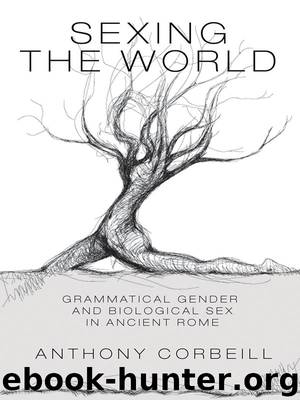Sexing the World by Corbeill Anthony;

Author:Corbeill, Anthony;
Language: eng
Format: epub
Publisher: Princeton University Press
Published: 2014-03-07T16:00:00+00:00
SHEDDING SNAKES
The various forms that the poetic manipulation of grammatical genders adopts in the poetry of Catullus reveal a learned poet exploiting to the fullest an inherited poetic trope by extending its practice in ways apparently not attempted by figures such as Ennius and Vergil, poets working in the more sober genre of epic. In contrast, my final pair of examples returns to the preoccupations of the previous two chapters: how notions of grammatical gender tie in with the origins of a language that reflects the natural world, and how those notions connect grammatical gender with human sexuality.
Snakes have mythical associations with shifting sexes. A particularly memorable tale, dating back to Hesiod, involves the famous Theban seer Teiresias.91 As a young man, Teiresias was wandering in the mountains when he came upon a male and female snake mating. Separating the two (and, in some versions, killing the female), he is suddenly transformed into a woman. Several years later he comes upon a similar sight, which provokes a similar response from the now transgendered seer. On this occasion he is restored to his masculine form. A less overt example of snakes effecting a sex change occurs in book 4 of On the Nature of Things. Lucretius is listing examples of the many objects in nature that give off bodies, among which he includes snakes while molting:
et item cum lubrica serpens
exuit in spinis vestem; nam saepe videmus
illorum spoliis vepres volitantibus auctas. (Lucr. 4.60–62)
… and also when the slick serpent (lubrica serpens)
doffs its covering onto thorns. For we often see
brambles covered with their (illorum) windblown spoils.
This short passage contains two oddities of grammatical gender. First, with the shedding of her skin, the feminine “slick serpent” (lubrica serpens) transforms into the masculine plural (“their”; illorum), as Lucretius presents the image of several discarded skins draping the bramble bushes. The noun serpens is recorded in the Roman grammarians as a noun that may have either gender, a fact that could have eased the transition here from feminine to masculine.92 Of noteworthy significance, however, is the fact that Lucretius himself uses the masculine—and not the feminine—in describing a serpens in the very next book of his epic (5.33: asper … serpens), which raises the suspicion that some poetic intent lies behind his calling attention to the fluidity of gender here. The second uncommon gender in the passage rests among the brambles (vepres), which Lucretius employs here in the feminine. This rarer gender drew the attention of the ancient commentators; Servius, for example, contrasts the Lucretian passage with Vergil’s use of the more standard masculine.93 In the context of Lucretius’s poem, however, these grammatical changes have a point. The example of snakes shedding their skins is one of the analogies he employs in arguing that physical bodies are continuously emitting material films, replicas of themselves that, among other phenomena, touch our eyes and ears so as to facilitate sight and hearing. With the shedding of her skin, the female serpent turns into a new form, signified by the male gender.
Download
This site does not store any files on its server. We only index and link to content provided by other sites. Please contact the content providers to delete copyright contents if any and email us, we'll remove relevant links or contents immediately.
| Africa | Americas |
| Arctic & Antarctica | Asia |
| Australia & Oceania | Europe |
| Middle East | Russia |
| United States | World |
| Ancient Civilizations | Military |
| Historical Study & Educational Resources |
The Fall of Carthage by Adrian Goldsworthy(1107)
The Mysteries of Mithra by Cumont Franz(1050)
Sacred Britannia: The Gods and Rituals of Roman Britain by Aldhouse-Green Miranda(902)
The Ghosts of Cannae: Hannibal and the Darkest Hour of the Roman Republic by Robert L. O'Connell(871)
The Satyricon by Petronius(843)
Selected Political Speeches by Marcus Tullius Cicero(842)
Rome's Gothic Wars: From the Third Century to Alaric by Michael Kulikowski(823)
The Poison King: The Life and Legend of Mithradates, Rome's Deadliest Enemy by Adrienne Mayor(820)
Fall of the Roman Republic (Penguin Classics) by Plutarch(809)
Letters from a Stoic (Classics) by Seneca(782)
Rubicon: The Triumph and Tragedy of the Roman Republic by Tom Holland(741)
In Defence of the Republic by Cicero(733)
Hadrian and the Triumph of Rome by Everitt Anthony(723)
Delphi Complete Works of Cicero by Cicero(687)
The Roman History by Cassius Dio(661)
Letters from a Stoic by Seneca(626)
The History of the Decline and Fall of the Roman Empire by David Womersley(624)
The Twelve Caesars (Penguin Classics) by Suetonius & Robert Graves(622)
The Spartacus War by Strauss Barry(583)
